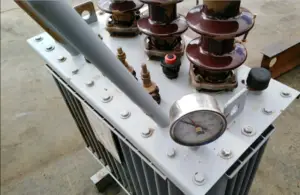Transformers play a crucial role in the electrical power distribution system, enabling efficient transfer of electrical energy between different voltage levels.
At the heart of every transformer lies the core, which serves as a pathway for the magnetic flux that facilitates energy conversion.
Transformer cores are predominantly made of laminated materials, and in this article, we will delve into the reasons behind this design choice, exploring the benefits and applications of laminated transformer cores.
Transformer cores are laminated to reduce energy losses and improve the overall efficiency of the transformer. Let’s go deep into the details!
Table of Contents
Transformer Core Basics
A transformer core is a vital component that helps establish the magnetic field necessary for the operation of transformers.
It is typically constructed using a specific type of material with high magnetic permeability, such as iron or steel.
Transformer cores can be categorized into different types, including laminated cores, solid cores, and powdered cores. However, laminated cores have gained widespread popularity due to their advantageous properties.
Understanding Lamination
Lamination refers to the process of creating a transformer core by stacking thin layers of magnetic material, usually in the form of steel laminations.
These laminations are insulated from each other to minimize the effects of eddy currents. The insulation can be achieved by using coatings or oxide layers between the laminations.
This lamination technique offers several significant benefits.
Factors Influencing Lamination of Transformer Cores
The decision to laminate transformer cores is driven by various factors related to core losses and efficiency.
Two major factors that influence this choice are core losses and eddy currents. Core losses result from hysteresis and eddy current effects, which can significantly impact the performance and efficiency of a transformer. Laminating the core effectively addresses these issues.
Advantages of Laminated Transformer Cores
Laminated transformer cores offer numerous advantages over their non-laminated counterparts.
One primary benefit is the reduction of eddy current losses. Eddy currents are induced within the core material due to alternating magnetic fields, leading to energy losses.
Laminations effectively impede the flow of these currents, resulting in reduced losses and improved efficiency.
Additionally, laminated cores minimize hysteresis losses, enhancing overall performance.
Let’s break this down and explain it in more detail!
Transformer cores are subjected to two main types of losses: hysteresis losses and eddy current losses.
- Hysteresis losses occur due to the cyclic magnetization and demagnetization of the core material, resulting in energy dissipation.
- Eddy current losses, on the other hand, are induced within the core material by alternating magnetic fields, causing additional energy losses.
By laminating the core, the flow of eddy currents is impeded. The thin layers of laminations act as barriers, restricting the path of these currents and reducing their intensity.
This effectively decreases the eddy current losses, leading to improved efficiency.
Furthermore, laminating the core also helps minimize hysteresis losses. The thin insulation layers between the laminations reduce the magnetic coupling between them, reducing the hysteresis effect and associated losses.
Overall, the lamination of transformer cores plays a crucial role in reducing energy losses, enhancing efficiency, and improving the performance of transformers.
the absence of lamination in transformer cores
If the core of a transformer is not laminated, several issues can arise:
Increased Energy Losses:
Non-laminated transformer cores experience higher energy losses compared to laminated cores. Eddy currents induced within the core material by the alternating magnetic fields are not effectively impeded.
These uncontrolled eddy currents result in significant energy dissipation and increased losses, leading to reduced efficiency.
Hysteresis Losses:
Without lamination, the core material is exposed to a continuous magnetization and demagnetization process during the alternating current cycle.
This results in higher hysteresis losses, where energy is lost as the core material repeatedly changes its magnetization state.
The absence of laminations prevents the reduction of magnetic coupling, exacerbating hysteresis losses.
Heating and Overheating:
The increased energy losses due to eddy currents and hysteresis can lead to excessive heat generation within the core.
Inadequate dissipation of this heat can result in the overheating of the transformer, which can lead to a decline in performance, insulation breakdown, and potential damage to the transformer.
Read also my article: Transformer Overheating? Here’s How to Cool It Down Quickly and Safely
Inefficiency and Reduced Performance:
The cumulative effect of increased energy losses and heating issues significantly reduces the overall efficiency and performance of the transformer.
The transformer may not be able to transfer electrical energy efficiently between voltage levels, resulting in power wastage and compromised functionality.
Increased Size and Weight:
Non-laminated cores require larger amounts of magnetic material to compensate for the higher losses. This leads to increased size and weight of the transformer, making it less practical and cost-effective.
Why is the core of a transformer laminated to reduce eddy current?
The core of a transformer is laminated to reduce eddy currents for several reasons:
Eddy Current Reduction:
Eddy currents are circulating currents induced within conductive materials, such as the core of a transformer, when exposed to changing magnetic fields. These currents cause energy losses and contribute to inefficiency.
By laminating the core, the flow of eddy currents is impeded. The thin layers of laminations act as barriers, restricting the path of these circulating currents and reducing their intensity.
Eddy Current Path Length:
Laminations increase the path length for eddy currents to circulate. As the laminations are insulated from each other, the eddy currents have to travel through a longer route, encountering more resistance and dissipating energy in the process.
This longer path reduces the magnitude of the eddy currents and the associated losses.
Resistance to Eddy Currents:
The insulation between laminations effectively isolates them from one another. This insulation prevents the formation of continuous conductive loops that would allow unrestricted eddy current flow.
By interrupting the conducting pathways, the laminations significantly increase the electrical resistance to eddy currents.
Magnetic Flux Concentration:
Laminated cores also help concentrate the magnetic flux within the desired pathways, improving the efficiency of the transformer.
As the magnetic flux passes through the laminated core, the insulation between the laminations helps to guide and direct the flux, reducing magnetic leakage and enhancing the magnetic coupling between the primary and secondary windings.
Minimization of Energy Losses:
By reducing the intensity and extent of eddy currents, laminating the core effectively decreases the energy losses caused by these circulating currents.
The reduction in eddy current losses leads to improved efficiency and performance of the transformer.
Lamination Techniques
The process of creating laminated transformer cores involves various techniques. The most common method is stacking, where individual laminations are stacked on top of one another to form the core.
Another technique is interleaving, where the laminations are staggered to reduce magnetic flux leakage.
The choice of materials for the laminations, as well as their thickness and orientation, can impact the core’s performance.
Challenges and Limitations of Laminated Cores
While laminated cores offer significant advantages, they are not without challenges and limitations.
One of the main challenges lies in the manufacturing process, which can be complex and time-consuming.
Additionally, the cost of producing laminated cores may be higher compared to other core types.
Design considerations and trade-offs also come into play, requiring careful optimization to achieve the desired performance.
Applications of Laminated Transformer Cores
Laminated transformer cores find widespread use in various applications, including power transformers, distribution transformers, and high-frequency transformers.
Power transformers, commonly used in electrical substations, rely on laminated cores to efficiently transfer energy across long distances.
Distribution transformers, found in residential and commercial areas, also benefit from laminated cores for improved performance.
High-frequency transformers, utilized in electronic devices and telecommunications equipment, require laminated cores to reduce losses and enhance efficiency.
Future Developments in Transformer Core Lamination
Continuous advancements in material technology and manufacturing processes hold promise for the future of transformer core lamination.
Research efforts aim to explore new materials with improved magnetic properties and reduced losses.
Innovations in manufacturing techniques seek to streamline the production of laminated cores, making them more cost-effective and readily available.
Additionally, alternative core designs are being investigated to further enhance the efficiency and performance of transformers.
Read also my comprehensive article: Unlocking the Mystery: Why Transformers Fail on DC Power.
Conclusion
Laminated transformer cores are a fundamental component in the efficient operation of transformers.
By reducing eddy current losses and minimizing hysteresis losses, laminated cores contribute to improved efficiency and performance.
Despite the challenges and limitations, the advantages offered by laminated cores make them the preferred choice for various applications, ranging from power transformers to high-frequency transformers.
As research and development in the field of transformer core materials and manufacturing processes continue, we can expect further enhancements in the design and performance of laminated transformer cores, paving the way for more efficient and sustainable electrical power systems.
Don’t Leave Empty-Handed!
Install my Free Android App on Google Play:
Electrical Cables Most Common Tables “Cables Tables”
And, my Electrical Calculations App “Fast Electrical Calculator”
Discover more great content by subscribing to My channel
Looking to stay ahead of the game in the world of electrical engineering? Subscribe to my YouTube channel and gain access to exclusive content you won’t find anywhere else!
The staff I recommend
(Amazon Affiliate Links to products I believe are high quality):
- Economy 120 Volt/60Hz AC Power Source – Step-Down Voltage & Frequency Converters 1800W
- UNI-T Digital Multimeter Tester UT139C
- 50-Amp Extension Cord for RV “100ft”
- Voltage Stabilizer 110/220v
- Hair Dryer “best selling“
- TOSHIBA EM131A5C-BS Countertop Microwave Ovens
Disclaimer: This contains affiliate links to Amazon products. I may earn a commission for purchases made through these links.


